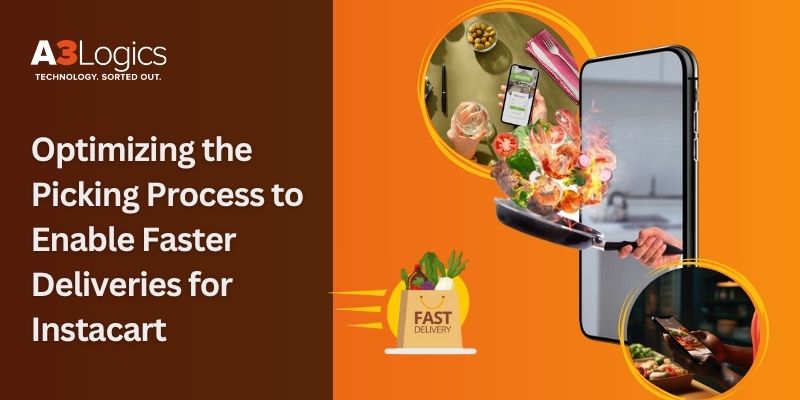Optimizing the Picking Process to Enable Faster Deliveries for Instacart

Speed matters in food and grocery delivery. When users order fresh groceries, they don’t want delays. This is why delivery platforms like Instacart need to focus heavily on their picking process—the part where shoppers collect ordered items from store shelves.
A slow or inefficient picking process can lead to late deliveries, unhappy customers, and lost business. But optimizing it means faster fulfillment, better shopper performance, and higher customer retention.
If you’re planning to build a grocery or food delivery platform, it’s crucial to learn how the picking process can impact your business. At A3Logics, a trusted Food Delivery App Development Company, we help clients build smarter, faster platforms from day one.
Let’s explore how to optimize the picking process to meet modern delivery expectations.
What Is the Picking Process in Food Delivery?
In platforms like Instacart, once a user places an order, a shopper is assigned to pick up all items from the store. This includes locating the right products, scanning them, placing them in the basket, and preparing them for checkout.
The challenge? Grocery stores are large. Some items are hard to find. Plus, multiple orders might be assigned to one shopper.
Every minute matters. And a poorly managed picking process means delays, wrong items, or canceled orders.
Why Optimizing Picking Is a Big Deal
Here’s what’s at stake if your picking process isn’t optimized:
- Slower deliveries: Users expect groceries within an hour or two. Picking delays ruin the promise.
- Inaccuracy: Mistakes in item selection cause refunds and complaints.
- Lower shopper productivity: If shoppers take too long, your operational cost rises.
- Poor ratings: Customers leave if service feels slow or unreliable.
Platforms like Instacart succeed because they invest in both app experience and backend workflows. The picking process is a key part of that backend. The smoother it runs, the better your service.
How Instacart Handles Picking
Instacart uses trained personal shoppers who receive detailed order lists via the app. These shoppers navigate the store, find products, scan barcodes, and confirm substitutions when needed.
Their goal is to complete picking fast—often in 20 to 30 minutes—so the delivery can begin immediately.
To do this, the platform uses:
- Smart routing in stores
- Real-time inventory checks
- Barcode scanning for accuracy
- AI-driven product suggestions
- Substitution approval from customers
These are the features your app should consider integrating to stay competitive.
Strategies to Optimize the Picking Process
1. Use Smart In-Store Navigation
Many delivery apps now include in-store maps or optimized routes based on item location. This allows shoppers to collect items in the most efficient order.
Why it matters:
- Cuts down walking time
- Improves shopper speed
- Reduces errors from backtracking
Shoppers no longer need to wander aisles—they move with a clear plan.
2. Group Orders Smartly
When one shopper handles multiple orders, the app should be smart about grouping them based on:
- Item similarity
- Store sections
- Delivery route
This avoids unnecessary trips across the store and reduces handling time.
Bonus: If two customers ordered the same milk brand, the shopper can pick both at once.
3. Enable Barcode Scanning in Shopper App
Scanning ensures the right product is picked, especially in stores with many similar variants.
Key benefits:
- Improves order accuracy
- Reduces refund requests
- Speeds up checkout at POS
It’s easy to integrate barcode scanning using the smartphone camera in your app.
4. Implement Real-Time Substitution Workflow
Not every item will be available in-store. That’s where substitutions come in.
Instead of calling or texting customers, the app should instantly show alternatives. The customer can approve or reject it in real-time.
This helps:
- Speed up decision-making
- Reduce shopper idle time
- Improve customer satisfaction
Smart recommendations also help shoppers make the best call even if the customer doesn’t respond.
5. AI-Powered Pick Lists
AI can analyze past orders, store layout, and current inventory to generate an optimized pick list. It’s like Waze, but for grocery aisles.
Why use it:
- Predictive route planning
- Adjusts based on time of day or store crowding
- Reduces order handling time
This type of automation gives your platform a huge edge.
6. Assign Experienced Shoppers for Complex Orders
Some orders are large or have special items like alcohol or deli meats. These should go to top-rated shoppers with the right certifications.
How it helps:
- Faster, smoother handling
- Better compliance with regulations
- Higher customer ratings
Your app’s backend should filter orders and assign them accordingly.
7. Incentivize Fast, Accurate Picking
Use gamification or reward systems to encourage top performance.
Offer bonuses for:
- Fast order completion
- Low error rate
- Positive customer feedback
This motivates your shopper base and improves overall service quality.
8. Integrate Inventory Systems with Partner Stores
Real-time product availability prevents delays. If an item is out of stock, don’t wait until the shopper is at the shelf.
How it helps:
- Avoids order edits
- Reduces shopper frustration
- Allows proactive substitutions
This needs collaboration with partner stores but adds huge value.
How A3Logics Can Help You Build Smarter Delivery Platforms
At A3Logics, we’ve built multiple custom food and grocery delivery apps tailored to modern business needs. As a trusted Food Delivery App Development Company, we provide:
- Smart shopper app modules
- Inventory integration
- AI-based pick list generation
- Real-time customer communication tools
- Custom dashboards for performance tracking
Whether you’re building a new app or upgrading your platform, we help you bring it to life with advanced features focused on speed, accuracy, and user satisfaction.
Conclusion: Optimize Picking, Deliver Faster, Grow Faster
In food and grocery delivery, faster fulfillment means happier customers. And to fulfill faster, your picking process must be airtight.
From AI-based navigation to barcode scanning and real-time substitutions, every detail counts. Instacart has set a high standard—and with the right development team, so can you.
Let A3Logics help you build or upgrade your food delivery platform with the smartest picking tools available. Your customers—and your shoppers—will thank you.
FAQs: Optimizing the Picking Process for Faster Deliveries
Q1. Why is picking important in food delivery apps?
The picking process directly affects delivery speed and accuracy. Efficient picking improves customer satisfaction and reduces operational costs.
Q2. How can barcode scanning help in the picking process?
Barcode scanning confirms item accuracy and reduces mistakes, which improves trust and speeds up checkout.
Q3. Can I use AI to optimize the picking route in stores?
Yes. AI can create smart pick lists and navigation routes based on store layout, time, and inventory data.
Q4. How can my app handle product substitutions better?
Real-time approvals, smart suggestions, and in-app communication help shoppers quickly confirm alternatives without delays.
Q5. How does A3Logics support picking optimization in delivery apps?
A3Logics provides custom development for shopper apps, inventory systems, AI features, and smart backend tools to optimize the picking process end-to-end.


